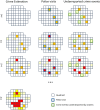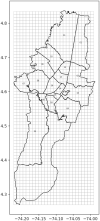Modelling underreported spatio-temporal crime events
- PMID: 37437032
- PMCID: PMC10337961
- DOI: 10.1371/journal.pone.0287776
Modelling underreported spatio-temporal crime events
Abstract
Crime observations are one of the principal inputs used by governments for designing citizens' security strategies. However, crime measurements are obscured by underreporting biases, resulting in the so-called "dark figure of crime". This work studies the possibility of recovering "true" crime and underreported incident rates over time using sequentially available daily data. For this, a novel underreporting model of spatiotemporal events based on the combinatorial multi-armed bandit framework was proposed. Through extensive simulations, the proposed methodology was validated for identifying the fundamental parameters of the proposed model: the "true" rates of incidence and underreporting of events. Once the proposed model was validated, crime data from a large city, Bogotá (Colombia), was used to estimate the "true" crime and underreporting rates. Our results suggest that this methodology could be used to rapidly estimate the underreporting rates of spatiotemporal events, which is a critical problem in public policy design.
Copyright: © 2023 Riascos Villegas et al. This is an open access article distributed under the terms of the Creative Commons Attribution License, which permits unrestricted use, distribution, and reproduction in any medium, provided the original author and source are credited.
Conflict of interest statement
NO authors have competing interests.
Figures











References
-
- Perry WL. Predictive policing: The role of crime forecasting in law enforcement operations. Rand Corporation; 2013.
-
- Grana G, Windell J. Crime and intelligence analysis: an integrated real-time approach. Routledge; 2021.
-
- Hart TC, Rennison CM. Reporting crime to the police, 1992–2000. US Department of Justice, Office of Justice Programs; Washington, DC; 2003.
-
- Xie M, Lauritsen JL. Racial context and crime reporting: A test of Black’s stratification hypothesis. Journal of quantitative criminology. 2012;28:265–293. doi: 10.1007/s10940-011-9140-z - DOI
-
- Xie M, Baumer EP. Neighborhood immigrant concentration and violent crime reporting to the police: A multilevel analysis of data from the National Crime Victimization Survey. Criminology. 2019;57(2):237–267. doi: 10.1111/1745-9125.12204 - DOI
Publication types
MeSH terms
LinkOut - more resources
Full Text Sources

